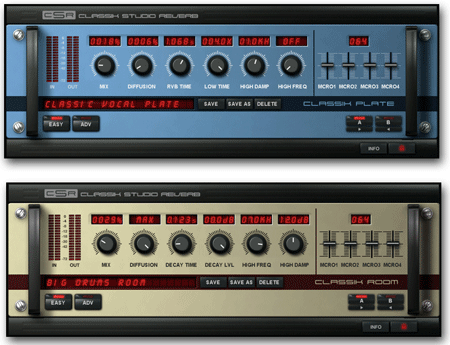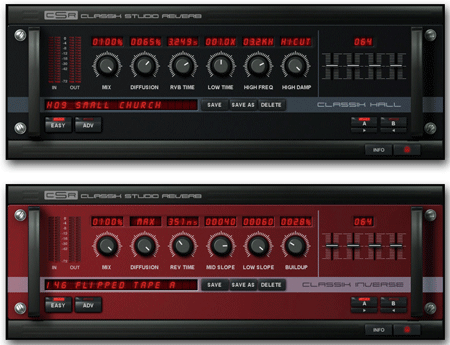
Barry's Mix Magazine Equipment And Software Reviews
Barry's Massive Discography And Engineering Career
Barry's Music Connection Magazine Reviews
Barry's Resolution Magazine Reviews
IK Multimedia Classik Studio Reverb
By Barry Rudolph
 |
 |
|
From Modena, Italy, comes IK Multimedia's Classik Studio Reverb, or CSR™ plug-in bundle. This is a solid collection of four reverbs that every music mixer, sound designer and film sound effects creator should own. The four plug-ins are Plate, Room, Hall and Inverse. Sold for $399 MSRP in VST, Audio Units and RTAS versions for both Mac OS X and Windows XP platforms, the product authorizes using a supplied Syncrosoft USB dongle. EASY AND ADVANCED MODES
Advance uncovers up to eight submenu buttons, including Macro and Mod buttons (more on these later) on CSR's virtual front panel. The five common submenu categories/buttons are I/O, Time, Reverb, Color and Reflections. I/O sets up the wet/dry mix, I/O levels and phase coherency using the Image control. Stereo image control is one of the best things about this plug-in and sets the plug apart from others when used creatively. The Time section controls pre-delays and everything about the reverb's length in the low and high frequencies. Reverb is about the size, diffusion, build-up, dispersion and modulation of the reverb's tail, while Color controls EQ. The Reflections menu has controls for the early reflections. Clicking on any of these buttons changes the same six virtual knobs used in Easy mode to a new set of parameters for each of the aforementioned five submenu categories. The Plate reverb has an additional Echo submenu for feeding up to 500 ms of echo delay into either the left or right reverb channels. MOD AND MACROS EXPLAINED
For sound design, Mod worked well for tailoring a reverb to react dynamically to sources; these are treatments whose finished sound relies predominately on the reverb itself. In film sound effects, this might be a horrific scream or a huge explosion reverb. I could change the reverb's length dependant on the level sent to it using the Envelope Generator or vary the reverb's output level using the LFO at a 3Hz sine wave rate--a tremolo-like effect. Other good candidates for modulation are Image In/Out and High Frequency Gain. Macros are four faders you can individually map to adjust several parameters at the same time. The Macro matrix is identical to Mod, and because the four Macro sliders and 29 other parameters of the plug-in are automatable, there is a lot of potential here. A good use of Macro would be to increase (and automate) the level and length of a reverb together for the end of a big sonic event--the sound of screaming and falling down a stairwell. IN THE STUDIO
If you are familiar with programming a Lexicon 480L or 960L reverb, you'll be right at home here but I usually found little need to get into the Advance settings. This reverb is very 'hearable' meaning you donŐt have to drown a source in it before you hear it. I liked Plate set short for vocals and some percussion, and the Room was realistic for drums and strings. The Hall reverb worked well for very long reverbs; it's smooth and luscious--the best of the four for its convincing spatial quality. Hall is great for legato strings, choirs or film/TV effects. Inverse is the "big hair" '80s effect, where the buildup is fully adjustable, unlike some of the original reverb boxes--back in the day. Inverse used in tiny amounts can fatten snare drums and percussion, and certain vocals sounded better with a pinch of this very distinctive effect. IS IT A CLASSIK?
IK Multimedia, 954/846-9101, www.ikmultimedia.com. |
|
|
|
All Web Page Design Is Copyright © 2006 through By Barry Rudolph